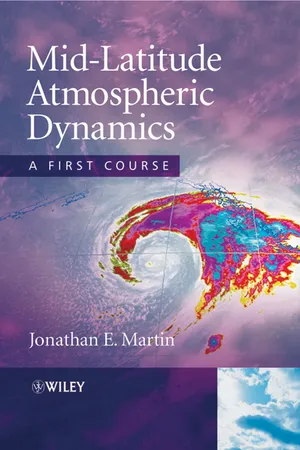
- English
- ePUB (mobile friendly)
- Available on iOS & Android
About this book
The first five chapters constitute a companion text to introductory courses covering the dynamics of the mid-latitude atmosphere. The final four chapters constitute a more advanced course, and provide insights into the diagnostic power of the quasi-geostrophic approximation of the equations outlined in the previous chapters, the meso-scale dynamics of thefrontal zone, the alternative PV perspective for cyclone interpretation, and the dynamics of the life-cycle of mid-latitude cyclones.
- Written in a clear and accessible style
- Features real weather examples and global case studies
- Each chapter sets out clear learning objectives and tests students' knowledge with concluding questions and answers
A Solutions Manual is also available for this textbook on the Instructor Companion Site www.wileyeurope.com/college/martin.
"…a student-friendly yet rigorous textbook that accomplishes what no other textbook has done before… I highly recommend this textbook. For instructors, this is a great book if they don't have their own class notes – one can teach straight from the book. And for students, this is a great book if they don't take good class notes – one can learn straight from the book. This is a rare attribute of advanced textbooks."
Bulletin of the American Meteorological Society (BAMS), 2008
Frequently asked questions
- Essential is ideal for learners and professionals who enjoy exploring a wide range of subjects. Access the Essential Library with 800,000+ trusted titles and best-sellers across business, personal growth, and the humanities. Includes unlimited reading time and Standard Read Aloud voice.
- Complete: Perfect for advanced learners and researchers needing full, unrestricted access. Unlock 1.4M+ books across hundreds of subjects, including academic and specialized titles. The Complete Plan also includes advanced features like Premium Read Aloud and Research Assistant.
Please note we cannot support devices running on iOS 13 and Android 7 or earlier. Learn more about using the app.
Information
1
Introduction and Review of Mathematical Tools
Objectives
1.1 Fluids and the Nature of Fluid Dynamics
Table of contents
- Cover page
- Contents
- Title page
- Copyright page
- Preface
- Acknowledgements
- 1 Introduction and Review of Mathematical Tools
- 2 Fundamental and Apparent Forces
- 3 Mass, Momentum, and Energy: The Fundamental Quantities of the Physical World
- 4 Applications of the Equations of Motion
- 5 Circulation, Vorticity, and Divergence
- 6 The Diagnosis of Mid-Latitude Synoptic-Scale Vertical Motions
- 7 The Vertical Circulation at Fronts
- 8 Dynamical Aspects of the Life Cycle of the Mid-Latitude Cyclone
- 9 Potential Vorticity and Applications to Mid-Latitude Weather Systems
- Appendix A: Virtual Temperature
- Bibliography
- Index